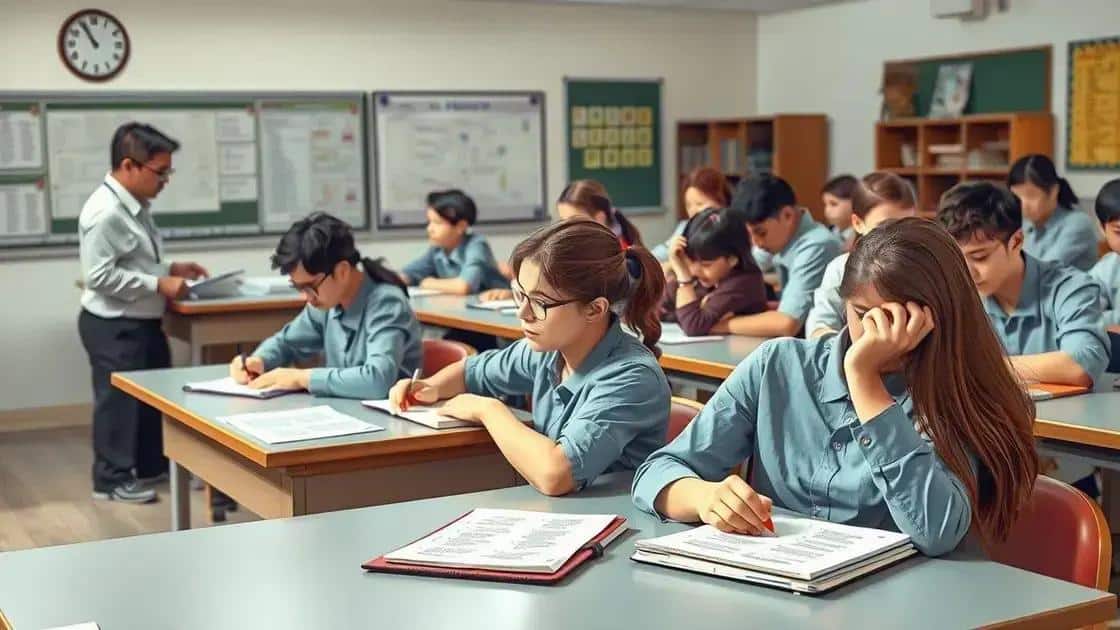Opposition to proposed national testing raises concerns

Opposition to proposed national testing stems from concerns about equity, student stress, and the effectiveness of standardized assessments, prompting advocates to seek alternative methods that better reflect student learning.
Opposition to proposed national testing is gaining momentum as stakeholders express their concerns about its implications. Have you ever wondered how standardized testing affects student learning and equity in education?
Understanding the proposed national testing
Understanding the proposed national testing is essential for grasping its potential impact on the education system. These assessments aim to evaluate student performance across various subjects consistently. But what do they really entail?
What is national testing?
National testing refers to standardized tests administered to students at a national level. They typically assess core subjects such as math, reading, and science. The goal is to measure student achievement and ensure educational standards are met across regions.
Goals of national testing
The primary goals include:
- Assessing student knowledge and skills
- Identifying learning gaps
- Informing educational policy decisions
By setting a unified standard, educators can better understand how students are performing nationwide. This can lead to enhancements in teaching methods and curriculum development.
Moreover, the results of these tests can impact funding and resources allocated to schools. Schools that perform well may receive more support, while those that do not may face challenges. However, this can create pressure on educators and students alike.
Concerns about implementation
Many people raise concerns regarding how national testing could affect education. For example, critics argue that standardized tests may not accurately reflect a student’s abilities. Factors like socioeconomic status and learning disabilities can impact scores significantly.
Test anxiety is another issue, with many students feeling stressed by the pressure to perform well. This stress can negatively affect their engagement with learning. Some also fear that a strong focus on testing could narrow the curriculum, causing schools to teach only what is tested rather than a well-rounded education.
In addressing these concerns, it’s essential to explore potential alternatives and enhancements to testing procedures. Discussions around alternative assessment methods are crucial. These may include projects, portfolios, or teacher assessments, which might provide a more comprehensive view of student understanding.
Key reasons for opposition to national testing
There are several key reasons behind the opposition to national testing. Many stakeholders, including educators and parents, express valid concerns regarding its implementation. Understanding these reasons can shed light on the ongoing debates in education.
Equity and fairness issues
One major concern is about equity. Standardized tests may not account for diverse backgrounds and learning styles. Students from different socioeconomic statuses might not have equal access to resources, impacting their test performance significantly.
High-stakes testing environment
The pressure associated with national tests can create a high-stakes environment. Students often feel anxious, which may hinder their performance. This stress can affect their overall learning experience and enthusiasm for education.
- Students may develop test anxiety, decreasing their confidence.
- Teachers might feel pressured to teach to the test, narrowing the curriculum.
- Schools can face penalties based on poor test results, impacting funding and resources.
This situation raises questions about the validity and fairness of results. When schools and educators focus solely on test preparation, they may lose sight of fostering a comprehensive education.
Alternative assessment methods
Advocates for different assessment methods argue that alternatives to standardized tests could provide a better understanding of student learning. For example, project-based assessments or portfolios allow students to demonstrate their knowledge more creatively and comprehensively. These methods could encourage collaboration and critical thinking.
Furthermore, incorporating teacher assessments can be beneficial. Teachers often have a deeper insight into their students’ abilities and challenges. By relying on their evaluations, schools can create a more personalized learning environment that respects individual growth.
Impact on teachers and students

The impact on teachers and students from national testing can be profound and far-reaching. These assessments not only shape how we measure educational success but also influence daily classroom activities.
Stress and pressure
For teachers, high-stakes testing can create a stressful environment. They often feel compelled to ensure that their students perform well. This pressure may lead to an overwhelming focus on test preparation, rather than fostering a love for learning.
Changes in teaching methods
National testing can also lead to changes in teaching methods. Educators might emphasize rote memorization and drill practices to boost test scores. This approach can limit creative teaching strategies that encourage critical thinking and problem-solving skills.
- Teachers may face burnout from the added stress of meeting testing standards.
- Some educators might leave the profession due to dissatisfaction with the testing environment.
- Test scores can determine funding and resources, affecting classroom supplies and support staff.
For students, the effects can be equally significant. Many students experience increased anxiety surrounding tests. When the emphasis is on scores, their overall learning and engagement may decline.
The role of student motivation
Motivation can take a hit when students feel their worth is tied to a single standardized test. Some may disengage from learning, viewing it as a means to an end rather than a journey of discovery. It’s vital to incorporate assessments that respect student individuality and promote a positive attitude toward education.
While testing can provide valuable data, it should not be the sole measure of student success. Balancing assessments with diverse teaching methods encourages a richer educational experience. This balance helps students understand the value of learning for its own sake, rather than just for a test score.
Alternative assessment methods
Alternative assessment methods provide an opportunity to measure student learning beyond traditional standardized tests. These approaches cater to diverse learning styles and can foster a deeper understanding of material. By focusing on various skills and abilities, educators can create a more holistic view of student progress.
Project-based assessments
One effective alternative is project-based assessments. These projects allow students to explore topics in depth, applying their knowledge in practical ways. Completing a project encourages critical thinking, collaboration, and creativity.
- Students can work in groups, enhancing teamwork skills.
- Projects often require research, boosting information literacy.
- Presenting their work helps improve communication skills.
Such assessments engage students more actively and can lead to a greater understanding of the subject matter.
Portfolios
Another option is using portfolios. A portfolio collects a student’s work over time, showcasing their growth and development. This method highlights individual progress, allowing for reflection on learning experiences.
Portfolios can include:
- Writing samples
- Artistic projects
- Recorded presentations
This method helps students take ownership of their learning and allows teachers to assess their skills meaningfully, without comparing them to standardized benchmarks.
Teacher assessments
Incorporating teacher assessments is another valuable approach. Educators often have a better understanding of their students’ abilities than any standardized test. By evaluating students through observations, class participation, and assignments, teachers can provide more personalized feedback.
These assessments can help identify students’ strengths and areas for improvement, leading to tailored instruction that meets individual needs. Furthermore, this personalized approach can motivate students to engage more deeply with the learning process.
The role of policy in education reform
The role of policy in education reform is crucial for driving changes that impact students, teachers, and the education system as a whole. Educational policies can dictate everything from curriculum standards to funding and assessment practices.
Influencing standards and expectations
Policies shape the standards and expectations for learning. They set the benchmarks that schools must meet. These guidelines help ensure that students across the nation receive a certain level of education. When policies change, they can have a direct impact on what is taught in classrooms.
Funding and resources
Another vital area affected by education policy is funding. Policies determine how resources are allocated to schools. Schools with more funding can provide better facilities, resources, and support staff. This inequity in funding can create disparities in educational opportunities for students.
- Wealthier districts often receive more, leading to enhanced learning environments.
- Low-income areas may struggle with outdated materials and lack of technology.
- Effective policies can help ensure fair distribution of resources to all schools.
Having equitable access to resources is essential for closing the achievement gap between students from different socioeconomic backgrounds.
Accountability measures
Policies also establish accountability measures to evaluate school performance. These measures often rely on standardized testing results. While accountability is important, reliance on test scores can lead to a narrow focus on teaching to the test.
Reforming assessment policies to include diverse evaluation methods can offer a more comprehensive view of student learning. It is essential for policymakers to balance accountability with innovations that promote a holistic education experience.
The ongoing debate around national testing highlights important issues that impact students and educators alike. While standardized tests aim to measure student achievement, many argue they do not tell the whole story. Alternative assessment methods, such as project-based work and portfolios, offer ways to provide a fuller picture of student learning. Policies play a crucial role in shaping these assessments and the resources available to schools. Balancing accountability with innovative teaching practices can lead to a more equitable education system that respects individual learning journeys.
Here’s a summary of key points regarding the issues discussed:
– **Impact on Students**: Standardized tests create stress and may not reflect true abilities.
– **Alternative Assessments**: Methods like portfolios and projects offer a broader view of learning.
– **Role of Policy**: Policies affect how education is funded and assessed, shaping student experiences.
– **Need for Equity**: Equitable access to resources is essential for closing achievement gaps.
– **Importance of Balance**: Balancing accountability with creativity enhances the education experience.
FAQ – Frequently Asked Questions about National Testing and Education Reform
What are the main concerns regarding national testing?
Many argue that national tests create stress for students and do not accurately reflect their true abilities.
How can alternative assessment methods benefit students?
Alternative assessments, like projects and portfolios, provide a broader view of learning and help showcase individual student strengths.
What role does policy play in education reform?
Policy shapes educational standards, funding, and evaluation methods, significantly influencing the quality of education.
Why is equity in education important?
Equity ensures that all students have the same access to resources and opportunities, helping to close achievement gaps.






